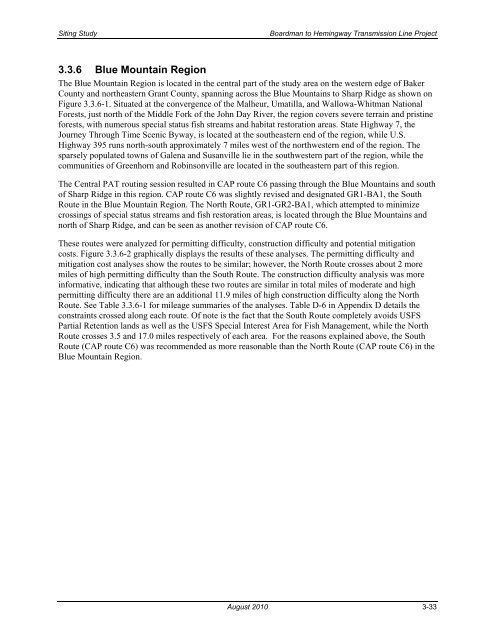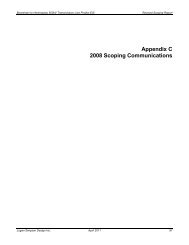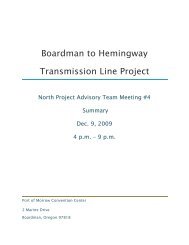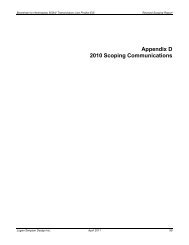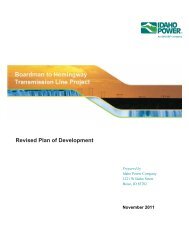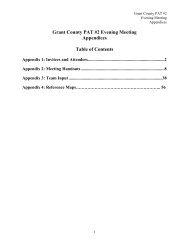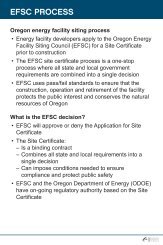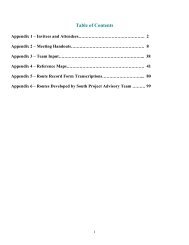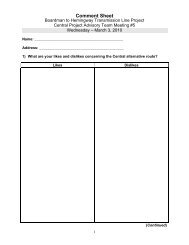Siting Study - Boardman to Hemingway Transmission Line Project
Siting Study - Boardman to Hemingway Transmission Line Project
Siting Study - Boardman to Hemingway Transmission Line Project
You also want an ePaper? Increase the reach of your titles
YUMPU automatically turns print PDFs into web optimized ePapers that Google loves.
<strong>Siting</strong> <strong>Study</strong><br />
<strong>Boardman</strong> <strong>to</strong> <strong>Hemingway</strong> <strong>Transmission</strong> <strong>Line</strong> <strong>Project</strong><br />
3.3.6 Blue Mountain Region<br />
The Blue Mountain Region is located in the central part of the study area on the western edge of Baker<br />
County and northeastern Grant County, spanning across the Blue Mountains <strong>to</strong> Sharp Ridge as shown on<br />
Figure 3.3.6-1. Situated at the convergence of the Malheur, Umatilla, and Wallowa-Whitman National<br />
Forests, just north of the Middle Fork of the John Day River, the region covers severe terrain and pristine<br />
forests, with numerous special status fish streams and habitat res<strong>to</strong>ration areas. State Highway 7, the<br />
Journey Through Time Scenic Byway, is located at the southeastern end of the region, while U.S.<br />
Highway 395 runs north-south approximately 7 miles west of the northwestern end of the region. The<br />
sparsely populated <strong>to</strong>wns of Galena and Susanville lie in the southwestern part of the region, while the<br />
communities of Greenhorn and Robinsonville are located in the southeastern part of this region.<br />
The Central PAT routing session resulted in CAP route C6 passing through the Blue Mountains and south<br />
of Sharp Ridge in this region. CAP route C6 was slightly revised and designated GR1-BA1, the South<br />
Route in the Blue Mountain Region. The North Route, GR1-GR2-BA1, which attempted <strong>to</strong> minimize<br />
crossings of special status streams and fish res<strong>to</strong>ration areas, is located through the Blue Mountains and<br />
north of Sharp Ridge, and can be seen as another revision of CAP route C6.<br />
These routes were analyzed for permitting difficulty, construction difficulty and potential mitigation<br />
costs. Figure 3.3.6-2 graphically displays the results of these analyses. The permitting difficulty and<br />
mitigation cost analyses show the routes <strong>to</strong> be similar; however, the North Route crosses about 2 more<br />
miles of high permitting difficulty than the South Route. The construction difficulty analysis was more<br />
informative, indicating that although these two routes are similar in <strong>to</strong>tal miles of moderate and high<br />
permitting difficulty there are an additional 11.9 miles of high construction difficulty along the North<br />
Route. See Table 3.3.6-1 for mileage summaries of the analyses. Table D-6 in Appendix D details the<br />
constraints crossed along each route. Of note is the fact that the South Route completely avoids USFS<br />
Partial Retention lands as well as the USFS Special Interest Area for Fish Management, while the North<br />
Route crosses 3.5 and 17.0 miles respectively of each area. For the reasons explained above, the South<br />
Route (CAP route C6) was recommended as more reasonable than the North Route (CAP route C6) in the<br />
Blue Mountain Region.<br />
August 2010 3-33


